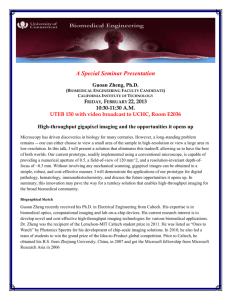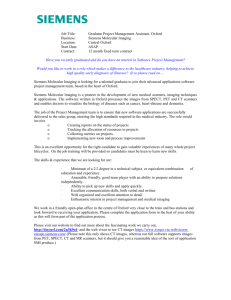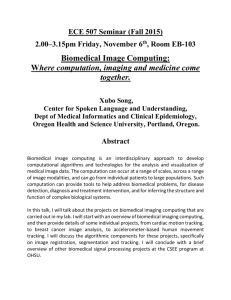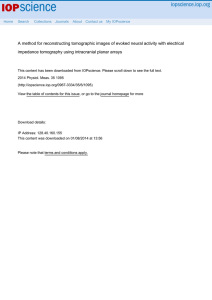Developing Big Data Image Analytics for Advancing Drug
advertisement
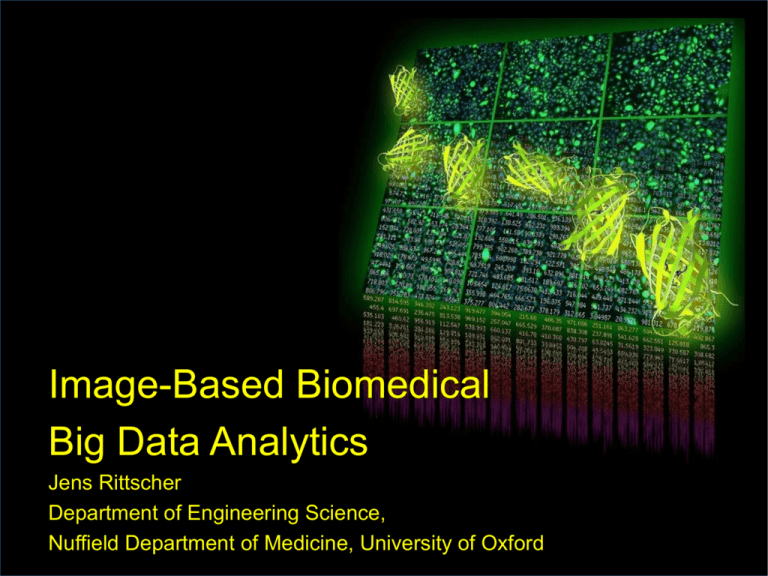
Image-Based Biomedical Big Data Analytics Jens Rittscher Department of Engineering Science, Nuffield Department of Medicine, University of Oxford 1 Cabability vs. Utility Technical Capability • Robotic imaging platforms are capable of generating large data sets • New imaging processes produce massive complex multi-channel data sets PE EnVision Platereader Labcyte Echo 555 GE IN Cell 6000 Confocal High Content Imager HRB SteriStore D Utility • Specific biological questions require very specific experimental designs • Systematic data collections are expensive and time consuming 2 Zebrafish Atlas / ICVGIP 2010 / 05/05/12 J. Tu,M. Bello, A. Yekta, J. Rittscher Zebrafish Normal development Developmental Defects ~1 mm ~3 mm Normal ~4 mm Treated 4 The Zebrafish Atlas Area Measures HEAD HIND BRAIN EAR EYE SWIM BLADDER MUSCLE NOTOCHORD MUSCLE FIN FIN GI TRACT Endpoint Colored area Head Light pink mesh Eye Black Ear Blue mesh Heart Medium green mesh Liver Red mesh Swim bladder Cyan mesh Gastrointestinal tract Light green mesh Upper muscle Yellow mesh Notochord Grey mesh Lower muscle (tail) Magenta mesh *Trunk area = body – head – ear – eye 5 The Zebrafish Atlas G I C E K Length Measures A H J Pericardial edema F L D Endpoint Measure Head width IJ Eye diameter GH Notochord length BC Tail length Pericardial edema index (PEI) Body length BD Abdominal width KL Trunk length CD B EF AB 6 Target Discovery Institute High-Throughput Screening Mass Sectrometry Chemical Biology Epigenetics Medical Chemistry Quantitative Imaging 7 Imaging Strategy Bio-Medical Imaging in Oxford Example: Cancer Research CRUK Oxford Centre Target Discovery Institute Clinical Image Data (CT, MRI, Pathology) Preclinical Research (+ Microscopy) High-Content Screening Mass-Spectrometry Improve Therapy Understand Disease Engineerin g Science Computer Vision Medical Imaging Drug Discovery 9 Big Data Theme & TDI Interactions Target Discovery Institute Experimental Platforms: • Phenotypic Screening • (Target based) HTS • Chemical Biology • Mass Spectrometry • Cell Biology • Medicinal Chemistry • Pharmacogenomics Research Areas: • Epigenetics in cancer, immunity & neurodegeneration • Proteostasis & UPS system • Chemical biology of epigenetic regulators Big Data Institute -Novel disease related target candidates -Correlative studies indicating novel relevant biological pathways Iterative Process -Omics data on biological pathways in human disease -Target discovery & validation – HT data -Drug mechanism of action, novel lead compounds Novel target candidates for human diseases Computational Platforms: • Biomedical data analytics • Modelling Research Areas: • Integrating human genome sequencing & clinical patient data • Information from clinical trials • Identification of target candidates for human diseases (NGS, GWAS) Computational Pathology Relevance & Impact Trend: Digitisation of histology slides changes current clinical workflows Opportunity: Automated analysis provides a broad spectrum of quantitative measurements Our focus: Develop computational framework to improve cancer diagnosis, manage treatment, and evaluate new therapies (e.g. immunotherapy) Cancer Immunotherapy Strategy to use the immune system to target tumours. Celebrated as a turning point in cancer and Science breakthrough of 2013 For the responding patients, this therapy together with others have prolonged patients survival for years rather than months. However, only 50% of patients respond. Question: How can we understand which patients will respond to therapy? J Couzin-Frankel Science 2013;342:1432-1433 Quantitative Tissue Imaging Challenge: Computational method that effectively assist pathologists and capture disease relevant information. Important aspects: • Detection of specific cell types (e.g. lymphocytes, goblet cells) • Assessment of structures such as glands, ducts, and blood vessels • Capturing the local tissue architecture. In summary: A visual vocabulary for tissue analysis Machine Learning 15 Moving Ahead • • • • Robust algorithms are one part of the puzzle. Build on robust algorithms to develop “enterprise level applications” Enable pattern recognition and mining across anatomical scales Enable biologists to interact and work with the data J. Rittscher, Characterization of Biological Processes through Automated Image Analysis (Review), Annual Review of Biomedical Engineering, 12, pages 315-344, August 2010 16 Image-based Biomedical Big Data Analytics Jens Rittscher Department of Engineering Science, Nuffield Department of Medicine, University of Oxford 1


